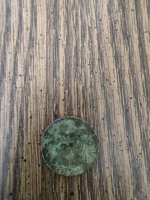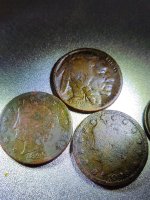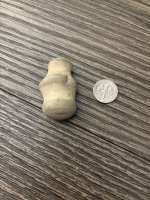kenb
Bronze Member
Archaeologists hit pay dirt in Bristol
Archaeologists Jennifer Banister (left) and Stephanie Storch scrape soil on top of a vat in search of pegs and other material. Archaeologists have uncovered 17 fermentation vats on the site, as well as the remains of a brick still base.
BRISTOL — Archaeologists digging at the site of a future condominium complex on Thames Street have discovered the remains of a rum distillery that likely played a role in Bristol's portion of the infamous Triangle Trade in the early 19th century.
Digging several feet below street grade in a vacant lot just north of Gillary's Tavern, researchers over the past five weeks have found approximately 17 molasses fermentation vats and the remains of a brick still base that would have helped fuel the distilling operation. Now, the state is working with developer James Roiter to come up with a plan to document the site before development begins.
"We're very excited about it," said Suzanne Cherau, who is heading the project for the archaeological contractor hired for the job, Public Archaeology Laboratory (PAL) in Pawtucket.
"Most of the time, 90 percent of the time, when we do projects we don't find anything. That 10 percent of the time, like this, is very exciting for us."
The state's principal archaeologist, Paul Robinson, is just as enthusiastic.
"This is a significant find," he said. "It's iconic, almost, of Bristol. We feel it is worthy of being on the National Register of Historic Places. It's one of the top three distillery operations (that have been found) in the northeast."
Archaeologist Jennifer Banister shows a small wooden peg that held the vats together.
The site
Bristol's close ties to the slave trade have long been known, and historians have also known for years that at least five rum distilling operations flourished in Bristol during the years the trade was active, the mid-1700s through the early 1800s.
Newport was also known for its distilleries and ties to the slave trade. Until now, though, only one still had been found in the entire state of Rhode Island. Ironically, that operation, uncovered by workers digging for the adjacent Thames Street Landing development about seven years ago, helped lead to the latest discovery.
After the Thames Street Landing site — known as Finney's distillery — was discovered, state archaeologists reasoned that there could be others nearby, and decided to require full archaeological surveys by future developers who planned large excavations in the area.
When Mr. Roiter appeared before the state Coastal Resources Management Council (CRMC) last year for approval for his project, CRMC officials sent a copy of his application to the state Historic Preservation and Heritage Commission (RIHPHC). Commission chairman Ted Sanderson said the commission responded to CRMC by requiring a site evaluation.
"We knew there was a good chance that something could be found," he said. "It's something that everyone knew existed, but not many had been found. We didn't want to lose the opportunity to study it."
Archaeologists examine one of approximately 17 molasses fermentation vats found on the site so far. They expect to do more site work and off-site research on the distillery, which appears to date from the early years of the 19th Century, at the peak of the slave trade.
Work pays off
PAL archaeologists arrived about five weeks ago and quickly found the first vat about four or five feet below grade. It didn't stop there. In all, researchers uncovered about 17 vats, though they still don't know the exact number. They also uncovered the brick still base, which Ms. Cherau said aided one of the last steps in the rum-making process.
"They would take the fermented molasses (from the vats) and siphon it into the still, which they then would heat," she said. The base supplied the heat.
Though archaeologists have taken a short break from digging, research into the site's history has been going on behind the scenes and has turned up a wealth of information.
Research shows that the operation, known simply as "The Distillery" in deeds, was run by a group of prominent Bristol businessmen who also owned a wharf and store directly across the street. The men — Jarvis and Joseph Pierce, Benjamin Bosworth, William Noyes, Nathaniel Paine and Thomas Lindsay — each owned shares in the operation and probably operated the still in the early years of the 19th century. However, she said, the site could have been in operation as early as the mid-1700s; she believes more research, both on and off-site, will yield more answers.
Close watch
The state is currently negotiating with Mr. Roiter on what will become of the site. Ms. Cherau said she hopes to return over the next several weeks and believes there is another week or so of field work left to do.
"We have to get a permit to do work, and then we'll do about another week of work," she said.
In the meantime, workers at the adjacent Belvedere Hotel project have been keeping a close eye on the lot to watch out for looters.
Ms. Cherau said bottle collectors might mistakenly find the site appealing, as references to rum conjure up images of rum bottles. However, she said, "this is not a bottle site. There was no bottling here; the rum was shipped out in barrels."
Mr. Roiter said he had a run-in with several diggers who walked onto the property earlier this week with shovels in hand.
The men were told to leave, he said, as the site is private and off-limits.
"It's really important that we preserve the site so the archaeologists can properly document it," he said. "From a history buff's standpoint it's fascinating, a reminder of Bristol's past. We have to be respectful of that."
---------
How the Triangle Trade worked
The so-called Triangle Trade flourished in the colonies and the fledgling American republic during the 1700s and early 1800s. Bristol and other northern towns played a vital role in the trade, and one of the north's chief commodities — New England rum, as it was called — was a key part of the triangle. Here is how the trade worked:
First leg
New England rum, distilled in establishments across New England, was loaded into hogsheads and large casks and shipped abroad, mostly to the west coast of Africa, by wealthy merchants and ship owners. At the height of the trade, Bristol reportedly had no fewer than five distilleries cranking out as much as 200 gallons of rum a day each. In Africa, the rum could be traded for slaves. One early account specified that one hogshead of rum was the equivalent of a healthy slave.
Middle leg
Having traded a portion of their rum for slaves in Africa, slavers set sail for the West Indies, where there was a ready market for more rum and slaves in the region's sugar plantations; other slaves found their way to southern plantations. Those slaves that weren't bartered for molasses, the key ingredient of the preferred New England rum, were sold, bringing big profits to the ship owners. Remaining rum would also be sold.
Final leg
Now laded with molasses, ship captains returned to Bristol and other northern ports with a tidy profit and a supply of the key ingredient in rum, which perpetuated the trade. When they returned, the cycle continued.
Profitable exercise
Though the slave trade was abolished in 1808, it proved so profitable that in Bristol and other places it continued to flourish for years following the abolition. An 1881 history of Bristol states that the trade continued in Bristol until about 1830, when the last of the town's distilleries closed. Faced with growing government vigilance in stamping out the trade, the business had "ceased to be profitable," the history reads.
By Ted Hayes
[email protected]
http://www.archaeologynews.org/story.asp?ID=240058&Title=Archaeologists hits pay dirt in Bristol
kenb
Archaeologists Jennifer Banister (left) and Stephanie Storch scrape soil on top of a vat in search of pegs and other material. Archaeologists have uncovered 17 fermentation vats on the site, as well as the remains of a brick still base.
BRISTOL — Archaeologists digging at the site of a future condominium complex on Thames Street have discovered the remains of a rum distillery that likely played a role in Bristol's portion of the infamous Triangle Trade in the early 19th century.
Digging several feet below street grade in a vacant lot just north of Gillary's Tavern, researchers over the past five weeks have found approximately 17 molasses fermentation vats and the remains of a brick still base that would have helped fuel the distilling operation. Now, the state is working with developer James Roiter to come up with a plan to document the site before development begins.
"We're very excited about it," said Suzanne Cherau, who is heading the project for the archaeological contractor hired for the job, Public Archaeology Laboratory (PAL) in Pawtucket.
"Most of the time, 90 percent of the time, when we do projects we don't find anything. That 10 percent of the time, like this, is very exciting for us."
The state's principal archaeologist, Paul Robinson, is just as enthusiastic.
"This is a significant find," he said. "It's iconic, almost, of Bristol. We feel it is worthy of being on the National Register of Historic Places. It's one of the top three distillery operations (that have been found) in the northeast."
Archaeologist Jennifer Banister shows a small wooden peg that held the vats together.
The site
Bristol's close ties to the slave trade have long been known, and historians have also known for years that at least five rum distilling operations flourished in Bristol during the years the trade was active, the mid-1700s through the early 1800s.
Newport was also known for its distilleries and ties to the slave trade. Until now, though, only one still had been found in the entire state of Rhode Island. Ironically, that operation, uncovered by workers digging for the adjacent Thames Street Landing development about seven years ago, helped lead to the latest discovery.
After the Thames Street Landing site — known as Finney's distillery — was discovered, state archaeologists reasoned that there could be others nearby, and decided to require full archaeological surveys by future developers who planned large excavations in the area.
When Mr. Roiter appeared before the state Coastal Resources Management Council (CRMC) last year for approval for his project, CRMC officials sent a copy of his application to the state Historic Preservation and Heritage Commission (RIHPHC). Commission chairman Ted Sanderson said the commission responded to CRMC by requiring a site evaluation.
"We knew there was a good chance that something could be found," he said. "It's something that everyone knew existed, but not many had been found. We didn't want to lose the opportunity to study it."
Archaeologists examine one of approximately 17 molasses fermentation vats found on the site so far. They expect to do more site work and off-site research on the distillery, which appears to date from the early years of the 19th Century, at the peak of the slave trade.
Work pays off
PAL archaeologists arrived about five weeks ago and quickly found the first vat about four or five feet below grade. It didn't stop there. In all, researchers uncovered about 17 vats, though they still don't know the exact number. They also uncovered the brick still base, which Ms. Cherau said aided one of the last steps in the rum-making process.
"They would take the fermented molasses (from the vats) and siphon it into the still, which they then would heat," she said. The base supplied the heat.
Though archaeologists have taken a short break from digging, research into the site's history has been going on behind the scenes and has turned up a wealth of information.
Research shows that the operation, known simply as "The Distillery" in deeds, was run by a group of prominent Bristol businessmen who also owned a wharf and store directly across the street. The men — Jarvis and Joseph Pierce, Benjamin Bosworth, William Noyes, Nathaniel Paine and Thomas Lindsay — each owned shares in the operation and probably operated the still in the early years of the 19th century. However, she said, the site could have been in operation as early as the mid-1700s; she believes more research, both on and off-site, will yield more answers.
Close watch
The state is currently negotiating with Mr. Roiter on what will become of the site. Ms. Cherau said she hopes to return over the next several weeks and believes there is another week or so of field work left to do.
"We have to get a permit to do work, and then we'll do about another week of work," she said.
In the meantime, workers at the adjacent Belvedere Hotel project have been keeping a close eye on the lot to watch out for looters.
Ms. Cherau said bottle collectors might mistakenly find the site appealing, as references to rum conjure up images of rum bottles. However, she said, "this is not a bottle site. There was no bottling here; the rum was shipped out in barrels."
Mr. Roiter said he had a run-in with several diggers who walked onto the property earlier this week with shovels in hand.
The men were told to leave, he said, as the site is private and off-limits.
"It's really important that we preserve the site so the archaeologists can properly document it," he said. "From a history buff's standpoint it's fascinating, a reminder of Bristol's past. We have to be respectful of that."
---------
How the Triangle Trade worked
The so-called Triangle Trade flourished in the colonies and the fledgling American republic during the 1700s and early 1800s. Bristol and other northern towns played a vital role in the trade, and one of the north's chief commodities — New England rum, as it was called — was a key part of the triangle. Here is how the trade worked:
First leg
New England rum, distilled in establishments across New England, was loaded into hogsheads and large casks and shipped abroad, mostly to the west coast of Africa, by wealthy merchants and ship owners. At the height of the trade, Bristol reportedly had no fewer than five distilleries cranking out as much as 200 gallons of rum a day each. In Africa, the rum could be traded for slaves. One early account specified that one hogshead of rum was the equivalent of a healthy slave.
Middle leg
Having traded a portion of their rum for slaves in Africa, slavers set sail for the West Indies, where there was a ready market for more rum and slaves in the region's sugar plantations; other slaves found their way to southern plantations. Those slaves that weren't bartered for molasses, the key ingredient of the preferred New England rum, were sold, bringing big profits to the ship owners. Remaining rum would also be sold.
Final leg
Now laded with molasses, ship captains returned to Bristol and other northern ports with a tidy profit and a supply of the key ingredient in rum, which perpetuated the trade. When they returned, the cycle continued.
Profitable exercise
Though the slave trade was abolished in 1808, it proved so profitable that in Bristol and other places it continued to flourish for years following the abolition. An 1881 history of Bristol states that the trade continued in Bristol until about 1830, when the last of the town's distilleries closed. Faced with growing government vigilance in stamping out the trade, the business had "ceased to be profitable," the history reads.
By Ted Hayes
[email protected]
http://www.archaeologynews.org/story.asp?ID=240058&Title=Archaeologists hits pay dirt in Bristol
kenb





